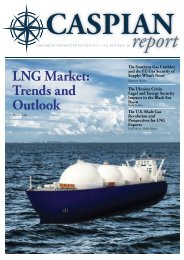Caspian Report - Issue: 07 - Spring 2014
You also want an ePaper? Increase the reach of your titles
YUMPU automatically turns print PDFs into web optimized ePapers that Google loves.
The decision of building the Trans<br />
Adriatic Pipeline (TAP) represented a<br />
major breakthrough in the development<br />
of the European natural gas system.<br />
The decision of building the Trans Adriatic<br />
Pipeline (TAP) represented a major<br />
breakthrough in the development of<br />
the European natural gas system. The<br />
pipeline will eventually materialise the<br />
Southern Gas Corridor, after a decade of<br />
public discussion but no actual investment<br />
decision, and it will allow a muchawaited<br />
diversification of the European<br />
import routes. TAP is indeed designed<br />
to transport the natural gas coming<br />
from the field of Shah Deniz, in the <strong>Caspian</strong><br />
offshore, to the EU final markets.<br />
TAP is not a stand-alone pipeline, but<br />
it is the final branch of a composed infrastructural<br />
system which will include<br />
the South Caucasus Pipeline (SCP) and<br />
the Trans Anatolian Natural Gas Pipeline<br />
(TANAP). SCP is an already existing<br />
pipeline, running for 700 km from<br />
the Azerbaijani production facilities<br />
through Georgia, up to the border with<br />
Turkey. SCP will be upgraded to transport<br />
additional volumes, through the<br />
laying of a second line along the same<br />
route of the existing one. TANAP will be<br />
the second section of the infrastructure<br />
and it will transport Azerbaijani natural<br />
gas across Turkey, following a new<br />
route of 1.700 km. TANAP will end at<br />
the border with Greece, where TAP<br />
will start. 1<br />
This last section will run across<br />
Greek and Albanian territory, with<br />
a secondary branch directed from<br />
Greece to Bulgaria. TAP’s main destination<br />
will be the Italian market,<br />
which will be the largest and most<br />
important gas market connected to<br />
the pipeline. Despite a protracted crisis,<br />
indeed, in 2013 Italy consumed<br />
approximately 70 billion cubic metres<br />
(bcm), remaining the second gas<br />
market in continental Europe after<br />
Germany. 2<br />
TAP will be a 760 km-long pipeline<br />
and its estimated construction costs<br />
amount to 5,7 billion euros, mainly<br />
concentrated in Greece and in the offshore<br />
between Albania and Italy. After<br />
its commissioning, TAP is expected to<br />
work for at least fifty years and the<br />
greatest share of its capacity will be<br />
devoted to supply the Italian gas system.<br />
In fact, out of a capacity of 10<br />
bcm per year, 8 will be marketed in<br />
Italy. As a consequence, the long term<br />
impact of the pipeline will be mainly<br />
concentrated in that country.<br />
23<br />
CASPIAN REPORT, SPRING <strong>2014</strong><br />
1.<br />
See TANAP website (http://www.tanap.com/en/) (accessed 30/04/<strong>2014</strong>).<br />
2.<br />
See Eurogas, Drop in 2013 EU gas demand emphasises need for swift change, 18/03/<strong>2014</strong>.










